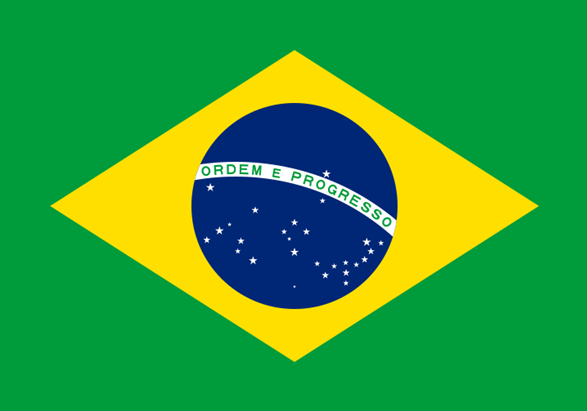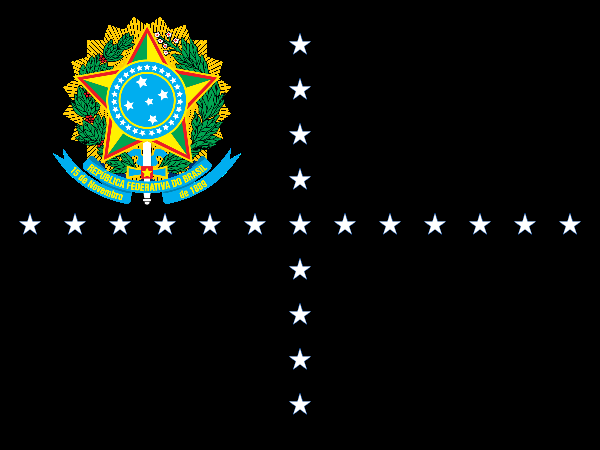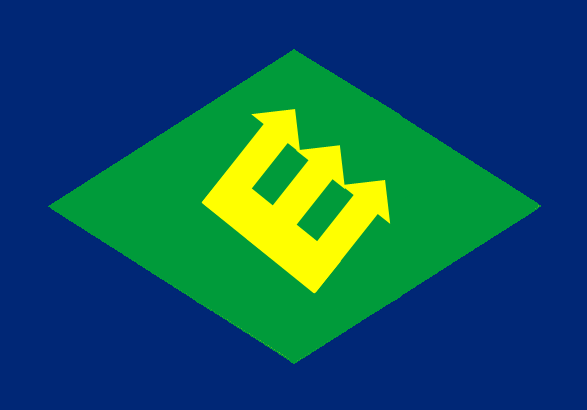BY LETTER
Brazil
History > 0030 to 0900 AT: Solsys Era > 030 to 130 AT: The Information Age
History > 0030 to 0900 AT: Solsys Era > 130 to 400 AT: The Interplanetary Age
History > 0030 to 0900 AT: Solsys Era > 400 to 530 AT: The Solsys Golden Age
History > 0030 to 0900 AT: Solsys Era > 530 to 900 AT: The Sundering
Galactography > Historical Polities
History > 0030 to 0900 AT: Solsys Era > 130 to 400 AT: The Interplanetary Age
History > 0030 to 0900 AT: Solsys Era > 400 to 530 AT: The Solsys Golden Age
History > 0030 to 0900 AT: Solsys Era > 530 to 900 AT: The Sundering
Galactography > Historical Polities
Brazil was a former Old Earth nation-state, which occupied a large portion of the South American continent and several colonies in Solsys Era Solsys.
History
It is believed that baseline humans lived on what would become Brazilian territory since at least 12,000 BT. Before the arrival of the Portuguese, a Christian people from Europe, around 470 BT the native populace lived in a multitude of prim-tech tribes mostly along the coast and the banks of major rivers. Portuguese explorers first settled near the coast and founded important cities such as Salvador and Rio de Janeiro. Later they began to venture further inland, expanding the colony's borders.Brazil eventually declared independence from Portugal and after decades as a slave owning monarchy became a republic. It is thought that for much of the Industrial Age, Brazil's economy was based around the export of raw materials such as precious metals and tropical wood and the production of cash crops including sugarcane and coffee. Political persecution and press censorship were often common during the periodic authoritarian regimes that ruled the country. Around 16 AT, democracy was restored and Brazil soon after began to gain influence, economic power, and technological prowess. Joined by the likes of India and Indonesia on the United Nations Security Council, Brazil became an important player on the world stage by the end of the Information Age. While Brazilians of the time were quick to embrace the internet and some other emergent technologies, many remained hostile to artificial intelligence and genetic and cybernetic augmentation.
The dawn of the Interplanetary Age was harsh for Brazil due to climate changes, proliferation of AI, and the global transition to a fusion-based economy. A prolonged economic crisis starting even before the Great Downturn impacted the majority of non-augmented civil population and established industries, causing unprecedented rates of unemployment and exacerbating other social problems. After a painful transition, the masses gradually dropped their conservatism regarding augmented humans having a more active role in the country's economy. Among the augmented citizens, a minority succeeded in achieving superbrighthood and replaced the superturings whenever it was possible. As those changes happened, Brazil developed strong anti-AI but pro-transhuman sentiments based on naturalist memes and the belief in the potential of humanity. Hatred against the "job-stealing artificial minds" provided a scapegoat to the frustrated unemployed masses and empowered the emerging superbright elite and consolidated their ideologies.
Enforcement of harsh AI-repressing acts and the provision of strong state support to baselines were done to protect the general populace from problems caused by the popularization of AI. This led to oppression, so several AI attempted to distance themselves from the human-led society, becoming solipsistic or ahuman. Others responded by initiating a long memetic struggle to gain rights and empower themselves in Brazilian society. An important AI organization founded during this time was the Liga Brasileira Solipsista (LBS), which struggled heavily for the emancipation of AI-kind and the acquisition of the right to run their virtualities in peace. By the early 200s AT, AI progressively succeeded in gaining greater civil rights.
One of the most important measures taken by the leaders of the time to deal with the crisis was to invest heavily in the national space industry. This included, with the assistance of the Organização Supranacional Sul-Americana (OSS), the construction of the space elevator Espaço and the Valparaiso Cycler. The nation, or its corporations, founded various space colonies and habitats mostly located in the inner system. Missions beyond the Asteroid Belt were much more expensive; nevertheless some bubblehabs were constructed on Jupiter and Saturn. Brazil was the first Earth nation to reach Neptune with a manned mission in 250 AT, led by Captain Samuel Neto, an early space adapted human.
Brazil was a founding member of the Council of Earth, and championed the development of green technology and envirotech systems. Aligned ideologically with states such as Cascadia, Brazil and its allies took an important role in the fight against climate change on Earth and the restoration of damaged ecologies. During the late 200s AT, Brazil saw its first president born off-world, Rafaela Otomar, elected. Legislation was eventually passed allowing AI participation in the decision making process. This included the creation of a position for a superturing AI adviser with powers similar to the vice-president. Furthermore, several laws and failsafes were implemented to impede situations such as an AI copying itself to gain more votes. Taken together, these changes and others gradually turned the nation into an early cyberdemocracy.
In the 300s AT, many of the Brazilian space colonies began to advocate for greater autonomy. In order to avert possible conflicts, Brazil often conceded independence and forged political and economic alliances with its former colonies. Brazil was among the first Earth polities to produce an S1 AI. The being was the ascended hyperturing named Ordem e Progresso, an AI that worked as an adviser to the political leaders of the nation. The first transapient in Brazil, e worked to revitalize the nation, in keeping with the desire of most citizens to retain their relevance in the Solar System. Likely it was because of this transapient that various would-be AI revolts were averted as e applied eir newfound social control capabilities to maintain peace in the state. Later, Ordem e Progresso worked with other South American transapients to advance the political and economic standing of the continent as well.
The 5th century AT was marked by several transformative events derived from the now-widespread use of nanotechnology, the birth of several new transapient beings, the shift in power in the Solar System, and the environmental restoration of Earth. Uploading was now viable, but Brazil went along with most nations in the prohibition of this technology. Uploading was seen in a bad light since the early uploaded minds tended to be damaged in some way. As time passed, provolves gained wider acceptance in human society much like AI had in the past. Vecs, however, were subject to continued prejudice thanks to their relatively recent population increase and the strength of pro-biont memes in Brazil at the time. Social tensions resulting from the toposophic differences of the modosophonts in Brazil were also starting to became less frequent and intense. Also during this century Brazil joined the League of the Americas and Australasia.
The calm and optimistic social climate prevalent at the beginning of the 6th century was utterly destroyed with the Technocalypse. Brazil suffered greatly like much of the rest of the Solar System. As the plagues ravaged the Earth, the social equilibrium the government and hyperturings worked hard to create and maintain was irrevocably broken. Criminality and hate-speech skyrocketed. Long forgotten groups, such the ultrasolipsist AIs of the LBS that remained underground in Amazonian territory, began to resurface and act in ways that contributed to further instability. This group of AIs were particularly troubling since their most advanced members managed to break through to hyperturinghood in ways considered unsafe or strange by the mainstream civilization of S1s at the time. They used their newfound toposophic level to employ an independently invented version of nanotechnology to deal with the perceived threats to their virtualities. This technology began to interact with the already very troublesome plagues and the blue goo as well in unpredictable manners, greatly hampering swarm defenses.
Brazil joined various other countries in the Treaty Org, and participated in the creation of GAIA. Over the decades, the Earth Goddess managed to deal with the effects of the Technocalypse but this ultimately led to the Great Expulsion. Several Brazilian groups attempted to negotiate or even fight with her, but failed horribly. The remaining Brazilians either went along with GAIA's arks to colonize other systems, remained on Earth following Her rules, or moved to space habitats or lunar colonies. The Brazilian government remained in existence for a few more decades. Brazil was legally dissolved in 641 AT, a few days after the main hyperturing serving the country committed suicide.
The Expulsos
After the dissolution of the government in exile, various refugee groups with ties to old Brazil banded together to face the perils of the Interplanetary Dark Age. Although sometimes with little more in common than speaking Portuguese derived languages, the Expulsos, as they called themselves, grew into one of the better known Trust Networks in the Solar System. Many Expulsos originated from the surviving Saturnine bubblehabs but their presence could be found throughout the system.
When the First Federation was founded most Expulsos groups joined. With Federation hyperturing guidance some founded extra-solar colonies such as Orinoco and Ordem e Progresso, now simply known as OrPro. After the First Federation's end, Expulsos groups were increasingly influenced by the emerging Sephirotic powers and eventually absorbed by the emerging galactic society. OrPro aligned with the Terragen Federation, eventually coming under the rule of the abstruse transapient Pindorama. The last record of a group self-identifying as an Expulsos was in the early 2200s AT.
Brazil in the Current Era
Much like the rest of Earth, the former Brazilian territory was restored by GAIA. Due to the current ice age and the reformation of ice caps, see levels have been reduced. The Amazonian Rainforest divided itself into two blocks, separated by a region of savanna that also extends itself through the central area. Affected by the dryness, the Atlantic Forest survives in patches of temperate forests in the central-south. It is expected that such fragments of the main Brazilian forests will merge once GAIA decides to end the ice age, fostering the biodiversity found there. The east of the Northeast region suffered greatly with the desertification process, being now mostly semiarid. Some places such as the Chaco, a region located in the central-western Brazil, and the Pampas in the south were also greatly affected by the lack of humidity, being covered by sand dunes. As for the rest of the southern part of Brazil, the predominant vegetation type found there is grassland.Most of the human settlements and constructions made prior to the Expulsion were dismantled. A few exceptions remain preserved however, such as the Cristo Redentor statue at Rio de Janeiro, the Elevador Lacerda that links the high and low terrain at Salvador, as well as important political buildings in Brasília such as the Congresso Nacional do Brasil and so on. All of these structures are surrounded by vegetation appropriate to the area they exist in, protected by semitransparent godtech bubbles created by the Earth Goddess.
The living sophonts in Brazil are mostly comprised of Amerindian descendants or lauzurogened individuals who form small communities usually at the coast and near major bodies of water. Rianthed modosophonts with the characteristics of jaguar, macaws, and several other native species can also be seen in the regions where their 'parent' animal species tend to live. Sophont dolphin-based clades inspired by legends of the "Boto cor-de-rosa" can be seen in the major rivers. Small underwater settlements of Merpeople exist scattered near the coast. Vecs, provolves and nearbaseline groups also inspired by several other Brazilian legends can be seen too, however they are somewhat more rare when compared to the mainstream sophonts living in Brazil.
Legacy of Brazil and the Expulsos
Outside of Solsys, OrPro, Orinoco, and a few other locations, only the slightest memetic traces of Brazilian culture are detected today. However, it is worth remembering that Brazil and the Expulsos played an important role in early Terragen history. Brazil was instrumental in the preservation of Earth's biodiversity during the climatic upheavals of the Information, Interplanetary, and Solsys Golden Ages. Brazilians created or greatly influenced several terraforming methods and environmental philosophies. A leader in space, they championed offworld colonization and development. Moreover, as some historians have argued, the Expulsos and other Trust Networks played an often-underappreciated role in preserving civilization during the Interplantary Dark Age. Even recently, some prankster minds in Cyberia gave credit to ancient Brazilian and Expulsos hackers and designers for influencing their modus operandi and philosophies. For most sophonts in the Current Era however, Brazil and its descendants are known only through historical virches if at all.Note: Given the severity of the Technocalypse, much of the data about pre-Great Expulsion polities such as Brazil itself was lost to time. The plagues and events derived from them caused the corruption or erasure of many historical records. As a consequence, not even the greatest AI God can present a completely accurate version of what happened during those times. However, high-toposophic minds can provide highly plausible versions of history derived from simulations consistent with the data discovered so far. The version described in this article is one of those versions, that is widely accepted by scholars at Ken Ferjik.
Related Articles
Appears in Topics
| 030 to 130 AT: The Information Age | 130 to 400 AT: The Interplanetary Age | 400 to 530 AT: The Solsys Golden Age |
| 530 to 900 AT: The Sundering | Historical Polities |
Development Notes
Text by Rakuen07
Initially published on 22 September 2018.
Initially published on 22 September 2018.









